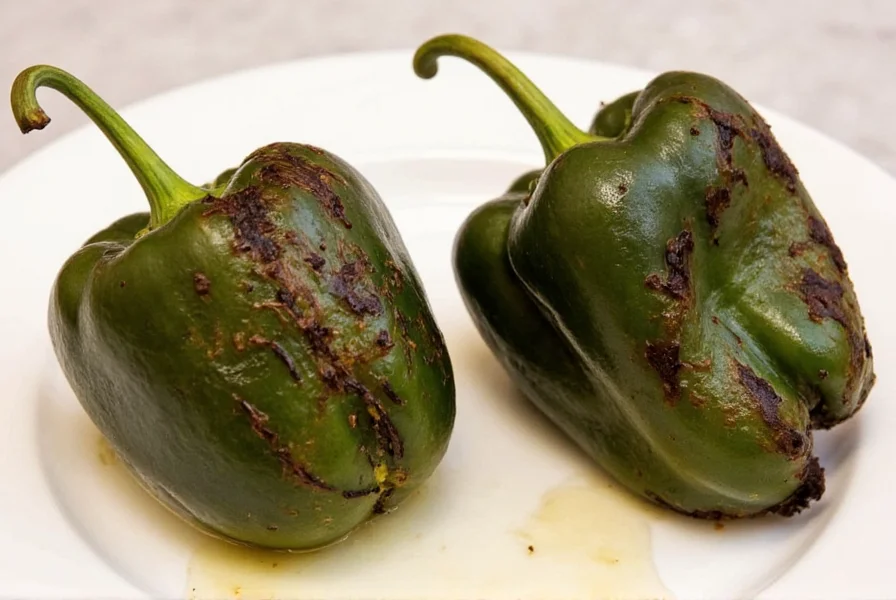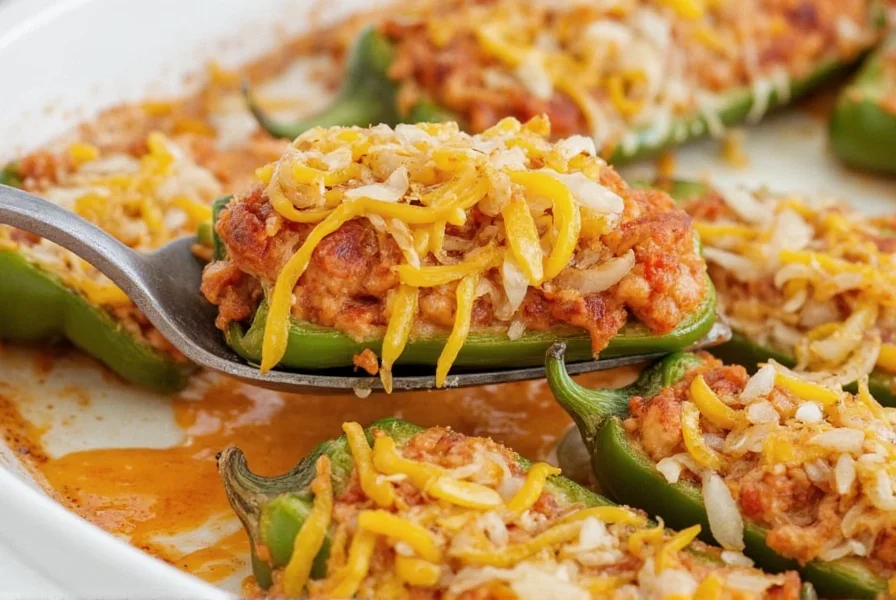The perfect stuffed poblano pepper recipe features roasted poblano peppers filled with a savory mixture of cheese, corn, and spices, then baked until tender. Total preparation time is 45 minutes with 25 minutes of active cooking. Key to success is properly roasting and peeling the peppers to remove their tough skin while maintaining structure for stuffing.
If you're searching for a genuine stuffed poblano pepper recipe, you've found a thoroughly tested method that delivers authentic Mexican flavors with reliable results. Poblano peppers, native to Mexico, offer a mild heat level (1,000-2,000 Scoville units) perfect for stuffing, unlike hotter varieties that might overwhelm other ingredients. This recipe creates chiles rellenos that balance smoky roasted pepper flavor with a creamy, cheesy filling that holds together during cooking.

Understanding Poblano Peppers for Stuffing
Poblano peppers (Capsicum annuum) are heart-shaped chili peppers that measure 4-6 inches long with dark green skin that turns red when mature. Their moderate heat level makes them ideal for stuffing compared to jalapeños or serranos. When selecting peppers for this stuffed poblano pepper recipe, choose firm specimens with smooth, unblemished skin and no soft spots. Heavier peppers typically contain more flesh and less seed cavity, providing better structure for stuffing.
Proper preparation is critical for the best stuffed poblano peppers. Roasting accomplishes three essential tasks: it loosens the tough outer skin for easy removal, enhances the pepper's natural sweetness through caramelization, and reduces raw bitterness. The traditional method involves direct flame exposure, but oven roasting works well for home cooks.
Authentic Stuffed Poblano Pepper Recipe
This authentic stuffed poblano pepper recipe serves four and creates tender peppers with a flavorful filling that doesn't leak during cooking. The cheese selection is crucial—Mexican melting cheeses like Oaxaca or Asadero work best, but Monterey Jack makes an excellent substitute.
| Preparation | Cooking | Total Time | Servings |
|---|---|---|---|
| 20 minutes | 25 minutes | 45 minutes | 4 servings |
Ingredients
- 4 large poblano peppers
- 1½ cups shredded Oaxaca or Monterey Jack cheese
- ½ cup corn kernels (fresh or frozen)
- ¼ cup diced onion
- 2 garlic cloves, minced
- 1 teaspoon cumin
- ½ teaspoon dried oregano
- Salt to taste
- 2 large eggs, separated
- ¼ cup all-purpose flour
- Vegetable oil for frying
- 2 cups tomato salsa (for serving)
Step-by-Step Preparation
- Roast the peppers: Place whole poblano peppers directly over gas flame or under broiler, turning frequently with tongs until skin blackens and blisters completely (about 8-10 minutes). Transfer to a sealed plastic bag for 10 minutes to steam, then carefully peel off charred skin while preserving pepper structure.
- Prepare filling: In a bowl, combine cheese, corn, onion, garlic, cumin, oregano, and salt. The mixture should hold together when pressed but not be overly wet.
- Stuff peppers: Make a small slit along the side of each pepper and carefully remove seeds while keeping the stem intact. Gently stuff with cheese mixture, being careful not to tear the pepper walls.
- Create egg batter: Beat egg whites until stiff peaks form, then fold in beaten yolks and flour until just combined. The batter should coat the back of a spoon.
- Fry stuffed peppers: Heat ½ inch of oil in skillet to 350°F (175°C). Dip stuffed peppers in batter, ensuring complete coverage, then fry 2-3 minutes per side until golden brown. Drain on paper towels.
- Final bake: Transfer to baking dish, bake at 375°F (190°C) for 10-12 minutes until filling is melted and peppers are tender but still holding shape.

Avoiding Common Stuffed Poblano Mistakes
Many home cooks encounter issues with stuffed poblano peppers that lead to disappointing results. Understanding these pitfalls ensures recipe success:
- Pepper selection: Overly large or thin-walled poblanos often collapse during stuffing. Choose medium-sized peppers with consistent thickness.
- Inadequate roasting: Skipping the roasting step leaves tough skin that affects texture. Properly roasted peppers should have completely blackened skin that peels away easily.
- Overstuffing: Excessive filling causes peppers to split during cooking. Fill to about ¾ capacity to allow for expansion.
- Wet filling: Moist ingredients like tomatoes or excess cheese can create steam pockets that burst the pepper. Keep fillings relatively dry.
- Incorrect oil temperature: Oil below 350°F creates greasy peppers; above 375°F burns the exterior before filling melts.
Variations for Different Dietary Preferences
This versatile stuffed poblano pepper recipe adapts well to various dietary needs while maintaining authentic flavor:
- Vegetarian stuffed poblano pepper recipe: The base recipe is naturally vegetarian. For enhanced protein, add black beans or quinoa to the filling.
- Vegan option: Substitute cheese with cashew cream cheese and nutritional yeast. Use aquafaba instead of egg batter.
- Meat lover's version: Add ½ cup cooked, seasoned ground beef or shredded chicken to the filling mixture.
- Gluten-free adaptation: Replace flour in batter with rice flour or cornstarch for a crispy coating.
- Spice adjustment: For milder peppers, remove all seeds and membranes. For extra heat, add a minced jalapeño to the filling.
Serving and Storage Recommendations
Serve stuffed poblanos immediately while the exterior remains crisp and the cheese filling is molten. Traditional accompaniments include:
- Simple tomato salsa or tomatillo verde
- Mexican red rice
- Refried beans
- Avocado slices or guacamole
For storage, place cooled stuffed poblanos in an airtight container in the refrigerator for up to 3 days. Reheat in a 350°F (175°C) oven for 15-20 minutes to maintain texture—microwaving makes the exterior soggy. You can also freeze uncooked stuffed peppers for up to 3 months; thaw in the refrigerator before cooking.
Frequently Asked Questions
Can I prepare stuffed poblano peppers ahead of time?
Yes, you can roast and stuff poblano peppers up to 24 hours in advance. Store them covered in the refrigerator, then proceed with the batter and cooking steps when ready to serve. For best texture, don't apply the egg batter until just before cooking.
What's the best cheese for stuffed poblanos?
Oaxaca cheese provides the most authentic melting quality, but Monterey Jack offers excellent meltability with mild flavor. Avoid pre-shredded cheeses which contain anti-caking agents that prevent proper melting. A blend of 75% melting cheese with 25% queso fresco adds flavor complexity.
How do I prevent stuffed poblanos from splitting during cooking?
To prevent splitting, make only a small incision for stuffing rather than cutting the pepper in half. Fill gently without overpacking, leaving about ½ inch space at the top. When frying, maintain oil temperature at 350°F and don't overcrowd the pan, which causes temperature drops that lead to uneven cooking.
Can I bake instead of fry stuffed poblano peppers?
Yes, though frying creates the traditional crispy exterior. For baking, brush stuffed peppers with beaten egg and bake at 400°F (200°C) for 25-30 minutes until golden and filling is melted. The texture will be softer but still delicious, making this a good option for those avoiding fried foods.











 浙公网安备
33010002000092号
浙公网安备
33010002000092号 浙B2-20120091-4
浙B2-20120091-4